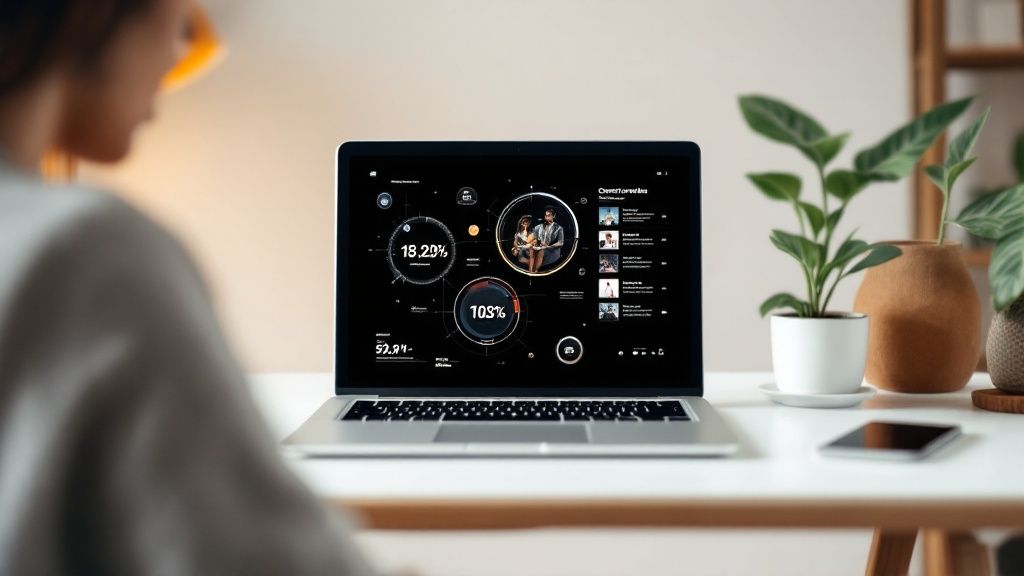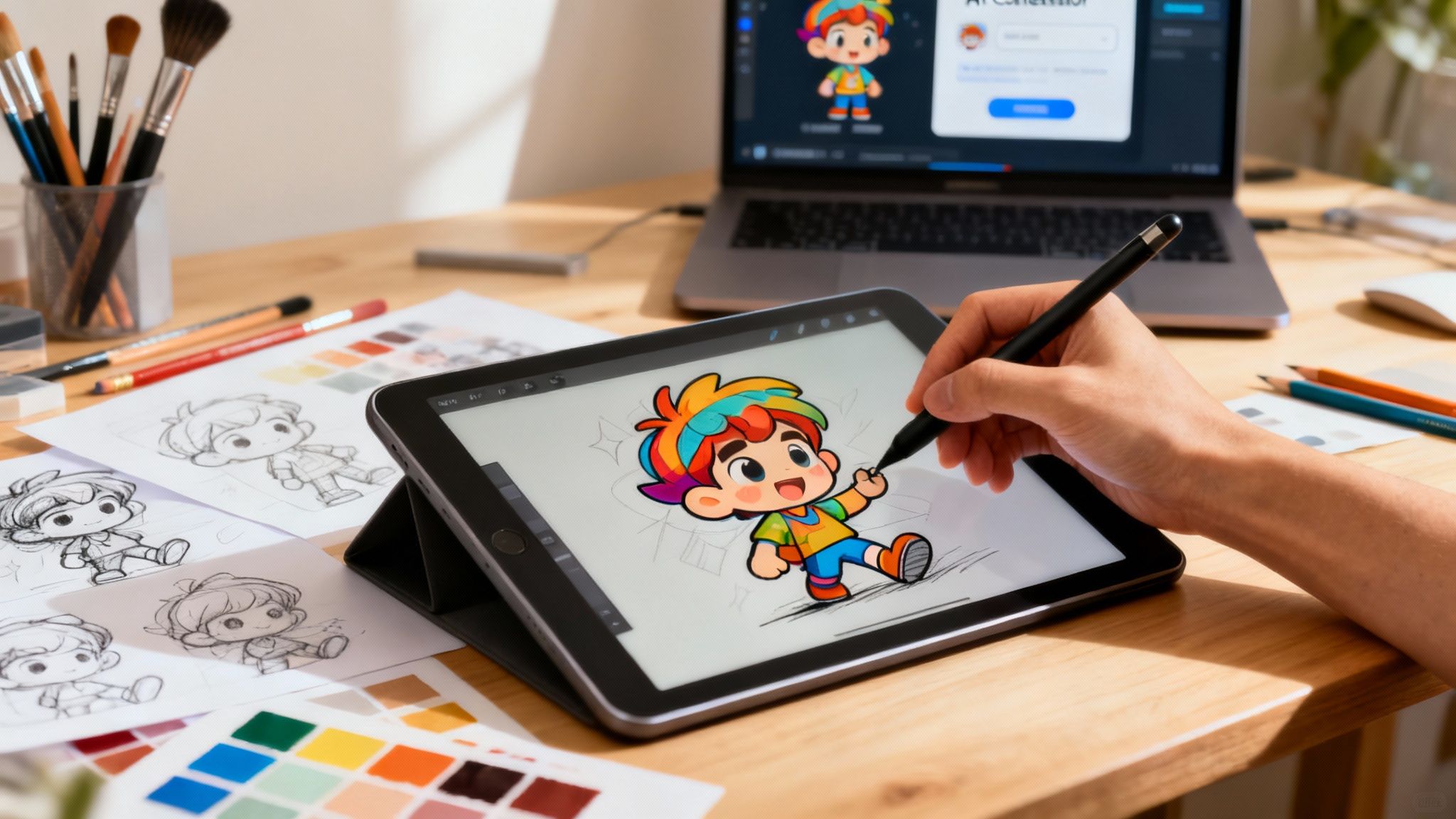
Meta Description: Learn how to use AI for content creation to beat burnout, generate ideas, and build an efficient workflow. A practical guide for marketers and creators.
Let's be real—the pressure to pump out fresh, high-quality content day after day is a direct path to creative burnout. It’s a feeling marketers and creators know all too well. If you're constantly battling the blinking cursor and struggling to keep up, you're not alone. This is where using AI for content creation comes in, not as a replacement for your talent, but as an incredibly smart collaborator. Think of it as a way to handle the grunt work—generating ideas, banging out first drafts, and even mocking up visuals—so you can get back to the high-level strategy that actually moves the needle.
Beat Creative Burnout with AI

The demand to always be creating is relentless. That constant churn drains your creative energy and makes it nearly impossible to focus on the big picture. For content creators and agencies, this isn't just frustrating; it's a bottleneck that slows down growth. When you're buried in the day-to-day grind of production, innovation and strategy are the first things to go. This is exactly why bringing AI into your workflow is so powerful. It’s not just about doing more, faster. It’s about creating smarter by automating the tedious, repetitive parts of the job, freeing you up for strategic thinking. If you’re staring at a blank page, AI can be the breakthrough you need. We dive deep into practical strategies for this in our guide on how to overcome writer's block.
Building Your Smart AI Content Toolkit
Let's be honest, picking the right AI tools isn't about finding a single "magic bullet" that does everything. It’s about building a smart, personalized toolkit that works for you. With the global AI market expected to hit a staggering $391 billion by 2025, the number of options out there can feel overwhelming. If you want a deep dive, you can check out our full guide to the best AI tools for content creation, where we break down our top picks. The key is to match the tool to the task. Are you writing blog posts? Creating video scripts? Designing social media graphics? Each goal requires a different kind of assistant.

A Framework for Choosing Your Tools
To cut through the noise, use a simple framework. Categorize tools by their main job and identify the non-negotiable features for your workflow. This helps you avoid shiny object syndrome and focus on what will actually move the needle.
Here’s a quick table to help you think through your own needs.
| AI Tool Selection Framework | |||
|---|---|---|---|
| Tool Category | Primary Use Case | Key Features to Look For | Best For |
| AI Writers | Generating long-form content, ad copy, scripts, and emails. | Brand voice customization, SEO integration, multiple output formats. | Bloggers, marketers, and copywriters. |
| AI Image Generators | Creating unique visuals, concept art, and social media graphics. | Style consistency, high-resolution output, prompt interpretation accuracy. | Graphic designers and social media managers. |
| AI Video & Audio Editors | Editing podcasts, creating videos from text, and cleaning up audio. | Text-based editing, AI avatars/voiceovers, auto-transcription. | YouTubers, podcasters, and corporate trainers. |
| Workflow Platforms | Integrating multiple AI tools into a single, cohesive process. | Centralized asset management, team collaboration, automated sequences. | Content teams and agencies. |
Ultimately, the goal isn't just to collect a bunch of tools. It’s to build a cohesive tech stack where each component talks to the others, creating a smooth and efficient workflow. There are plenty of lists of the best AI tools for content creators out there to get you started.
👉 Try MediaWorkbench.ai for free – schedule your posts and generate AI content in one place!
Crafting Text That Resonates with Your Audience
Getting quality text from an AI isn't just about typing in a command—it’s a conversation. The real magic happens with prompt engineering, which is a practical way of saying you need to give the AI detailed instructions. Think of it like briefing a new writer on your team. You wouldn't just tell them, "write about marketing," and expect a masterpiece. You'd give them context, define the audience, and show them examples of the style you're after. A vague prompt will get you a generic, soulless piece of content. A specific, detailed one turns the AI into a genuinely helpful collaborator. It's a strategy that’s already paying off for tons of marketers. In fact, a whopping 71.7% of content marketers now use AI to help with outlining, and 57.4% use it to get initial drafts on the page. You can dig into more of these stats on how AI is shaking up content workflows over at Siege Media.
Generating On-Brand Visuals Instantly

In a world that scrolls first and reads later, custom imagery is your secret weapon. But getting it made is usually slow and expensive. That's where AI completely flips the script. Forget sifting through stock photos or waiting on a designer. You can now generate stunning, perfectly on-brand visuals just by typing a few words. No design degree or big budget required. The magic, of course, is all in the prompt. You have control over everything from the artistic style and color palette to the exact dimensions you need for a blog header or an Instagram post.
Key Prompting Techniques
Think of it like giving directions to a ridiculously talented, lightning-fast artist. The more specific you are, the better the result.
- Style References: Don't just say "a picture of a cat." Say "minimalist line art of a cat" or "a photorealistic photo of a cat." The style descriptor is everything.
- Negative Prompts: Just as important as what you want is what you don't want. Adding a command like
--no textor--no blurry backgroundhelps clean up your image and remove distracting elements. - Aspect Ratios: Need a wide image for your website's hero section? Add
16:9to your prompt. Making a square graphic for social media? Use1:1. This simple command saves you a ton of cropping and editing headaches later.
If you're ready to jump in and start creating, we've put together a hands-on walkthrough of the best AI image generators to get you started.
How to Integrate AI into Your Content Workflow
Dabbling with a few AI tools here and there is one thing. But building a true system around them? That’s where the real power is. A genuine content engine isn’t just about using AI for one-off tasks. It’s about creating a connected workflow that moves seamlessly from AI-powered ideation and keyword research right into drafting, creating visuals, and scheduling it all out. This is how you turn a series of isolated actions into a scalable, predictable process. By 2025, over 80% of marketers had already embedded AI into their core processes. A significant 43% were using it specifically for content creation, which shows just how essential these integrated systems have become. Think of a platform like MediaWorkbench.ai as the central nervous system for this operation. It automates all the repetitive, manual work, freeing up your team to focus on what humans do best: high-level strategy and creative thinking. This is how you scale your content output without losing that authentic touch. Plus, when everything is tracked in one place, you gain incredible insights. You can start to see what’s working and what isn’t, which is critical for learning how to measure content performance. To get a bigger picture of where this is all heading, it's worth exploring the broader AI applications in digital marketing.
Build Your AI-Powered Future Today
We've covered a lot of ground, from beating creative burnout with AI to building an efficient workflow that actually works. The key insight is that using AI for content creation is here to boost your creativity, not replace it. Think of it this way: you’re still the architect, the visionary. AI is just the super-powered toolkit that helps you build bigger and faster than ever before. It’s about breaking through creative ruts, scaling your output without burning out, and freeing up your time to focus on the big-picture strategy that truly matters. This isn’t some far-off concept; it’s a practical partnership between your unique human insight and incredibly powerful machine intelligence. You now have the roadmap to make that a reality for your brand. Ready to put it all into practice? Explore the features of MediaWorkbench.ai and see how it pulls everything—from smart content generation to scheduling—into one unified platform.

